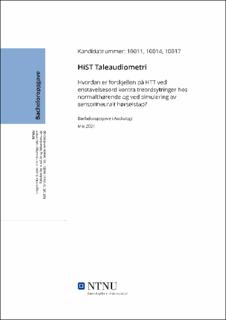| dc.contributor.advisor | Lindseth, Marte Kristine | |
| dc.contributor.author | Stiegler, Marthe Thomassen | |
| dc.contributor.author | Gresset, Rosmari Neuenkirchen | |
| dc.contributor.author | Røbekk, Signe | |
| dc.date.accessioned | 2021-09-25T16:28:31Z | |
| dc.date.available | 2021-09-25T16:28:31Z | |
| dc.date.issued | 2021 | |
| dc.identifier | no.ntnu:inspera:80618268:80619017 | |
| dc.identifier.uri | https://hdl.handle.net/11250/2783154 | |
| dc.description.abstract | Sammendrag
Bakgrunn: I dette prosjektet er det tatt for seg to typer talemateriale innenfor HiST taleaudiometri. Talematerialene er anbefalt for ulike formål, enstavelsesord for å finne MD og treordsytringer for å finne HTT. Tross dette finnes det ulike prosedyrer rundt om på de forskjellige høresentralene i Norge. Erfaringsmessig blir enstavelsesord også brukt til å finne HTT, til tross for anbefalingene. På bakgrunn av dette er vi interessert i å se på forskjellen i HTT ved disse to talematerialene, både ved normal hørsel og simulert sensorineuralt hørselstap.
Metode: Deltakerne besto av 23 voksne med normal hørsel (16 kvinner og 7 menn). De ble hentet internt i NTNU-programmet for audiologi. I forkant av datainnsamlingen gjennomførte deltakerne andre tester for å avdekke mulige ekskluderinger. Det ble målt HTT med enstavelsesord og treordsytringer, med og uten simulering. Simuleringen ble gjennomført med SWN, og skulle forestille et sensorineuralt hørselstap med en PTA4 på 60 dB HL.
Resultat: Resultatet viser at det er en signifikant forskjell i HTT målt med de forskjellige talematerialene, både ved normalthørende setting og ved simulert setting. Resultatet viser også at variasjonen i HTT hos deltakerne var større ved enstavelsesord enn ved treordsytringer, målt med begge settingene. Derimot var det større forskjell blant HTT hos normalthørende uavhengig av testmaterialet.
Konklusjon: De signifikante forskjellene i HTT mellom de to testmaterialene er verdt å merke seg i en klinisk setting. Det er usikkerhet rundt hvordan simuleringen i dette prosjektet fungerte, og vi anbefaler derfor videre forskning rundt denne problemstillingen. Dersom det ikke lar seg gjøre å teste på personer med sensorineurale hørselstap, kan filtrering av talesignalet være en god måte å simulere på. Det vil da ligne mer på en typisk audiogramkonfigurasjon som ses ved et sensorineuralt hørselstap. | |
| dc.description.abstract | Abstract
Background: In this project, two types of speech material have been addressed within HiST speech audiometry. The speech materials are recommended for various purposes, monosyllabic words to find WRS and three-word utterances to find SRT. Despite this, there are various procedures around the different hearing centres in Norway. Due to experience monosyllabic words are also used to find SRT, despite the recommendations. Based on this, we are interested in looking at the differences in SRT in these two speech materials, both in normal hearing and simulated sensorineural hearing loss.
Method: The participants consisted of 23 adults with normal hearing (16 women and 7 men). They were obtained internally in the NTNU program for audiology. Prior to the data collection, participants completed other tests to uncover possible exclusions. SRT was measured with monosyllabic words and three-word utterances, with and without simulation. The simulation was conducted with SWN and was supposed to represent a sensorineural hearing loss with a PTA4 of 60 dB HL.
Result: The result shows that there is a significant difference in SRT measured with the different speech materials, both at the normal setting and by simulation setting. The results also show that the variation in SRT in the participants was greater at monosyllabic words than in three-word utterances, measured within both settings. On the other hand, there was a greater difference among SRT in normal hearing regardless of the test material.
Conclusion: The significant differences in SRT between the two test materials are worth noting in a clinical setting. There is uncertainty about how the simulation in this project worked, and we therefore recommend further research on this issue. If it is not available to test for people with sensorineural hearing loss, filtering the speech signal can be a good way to simulate. It will then be more like a typical audiogram configuration seen in a sensorineural hearing loss. | |
| dc.language | nob | |
| dc.publisher | NTNU | |
| dc.title | HiST Taleaudiometri | |
| dc.type | Bachelor thesis | |
